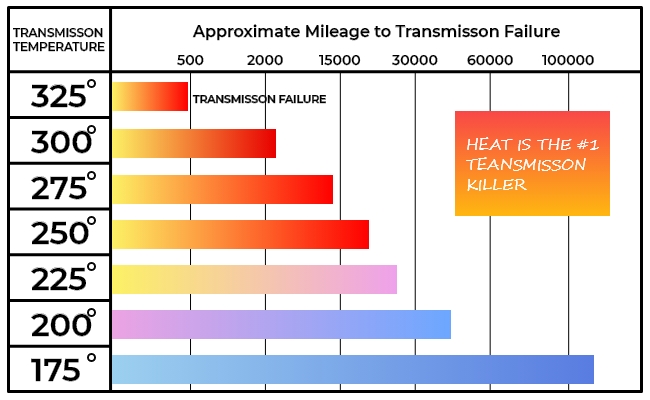Understanding your vehicle’s transmission temperature is crucial for its longevity. A healthy transmission operates within a specific temperature range. When it exceeds this range, it can lead to significant damage.
Safe Transmission Temperature Ranges
Generally, a normal transmission temperature falls between 175 and 225 degrees Fahrenheit (79 to 107 degrees Celsius). However, this can vary slightly depending on the vehicle model and driving conditions. Consult your owner’s manual for the manufacturer’s recommended operating temperature.
- Ideal Range: 175-200°F (79-93°C) ― Indicates efficient and normal operation.
- Acceptable Range: 200-225°F (93-107°C) ― May occur during heavy towing or hot weather. Monitor closely.
- Warning Zone: 225-250°F (107-121°C) ― Indicates potential problems. Reduce load and investigate.
- Danger Zone: Above 250°F (121°C) ― Significant risk of damage. Stop immediately and address the issue.
Causes of Transmission Overheating
Several factors can cause your transmission to overheat:
- Low Transmission Fluid: Insufficient fluid reduces lubrication and cooling capacity.
- Dirty Transmission Fluid: Contaminated fluid loses its ability to cool and lubricate effectively.
- Heavy Towing: Towing heavy loads puts extra strain on the transmission, generating more heat.
- Aggressive Driving: Rapid acceleration and frequent gear changes increase heat production.
- Stuck Torque Converter: A malfunctioning torque converter can generate excessive heat.
- Clogged Transmission Cooler: Debris can block the cooler, reducing its efficiency.
- Internal Transmission Problems: Worn-out clutches or other internal issues can cause friction and heat.
Fixes for Transmission Overheating
Addressing transmission overheating promptly can prevent costly repairs:
- Check Transmission Fluid Level: Ensure the fluid level is within the recommended range. Add fluid if necessary.
- Change Transmission Fluid and Filter: Replace old, dirty fluid and the filter to improve cooling and lubrication.
- Inspect Transmission Cooler: Check for blockages and clean the cooler thoroughly. Consider upgrading to a larger cooler if you frequently tow heavy loads.
- Repair or Replace Torque Converter: If the torque converter is malfunctioning, have it repaired or replaced by a qualified mechanic.
- Reduce Towing Load: Avoid exceeding your vehicle’s towing capacity.
- Drive Conservatively: Avoid aggressive driving habits that generate excessive heat.
- Check for Leaks: Inspect the transmission for any leaks and repair them promptly.
Monitoring Transmission Temperature
Many modern vehicles have a transmission temperature gauge on the dashboard; If your vehicle doesn’t have one, consider installing an aftermarket gauge or using an OBD-II scanner to monitor the temperature. Early detection of overheating can save you from major transmission problems.
By understanding normal transmission temperatures, recognizing the causes of overheating, and implementing appropriate fixes, you can protect your vehicle’s transmission and extend its lifespan.
Preventative Measures for Transmission Health
Beyond addressing overheating issues, proactive maintenance can significantly extend your transmission’s life and prevent future problems. Consider these preventative measures:
- Regular Transmission Service: Follow your vehicle manufacturer’s recommended service intervals for transmission fluid changes and inspections. This is often more frequent for vehicles subjected to heavy use or towing.
- Use the Correct Transmission Fluid: Always use the type of transmission fluid specified in your owner’s manual. Using the wrong fluid can lead to poor performance and damage.
- Avoid Overloading Your Vehicle: Exceeding your vehicle’s weight capacity puts undue stress on the transmission and other components.
- Smooth Driving Habits: Gentle acceleration and braking reduce stress on the transmission. Avoid abrupt shifts and unnecessary gear changes.
- Warm-Up in Cold Weather: Allow your engine and transmission to warm up for a few minutes before driving in cold weather. This allows the fluid to circulate properly and lubricate the components.
- Professional Inspections: Have your transmission inspected by a qualified mechanic periodically, especially if you notice any unusual noises, slipping, or rough shifting.
Understanding Transmission Fluid Types
Different vehicles require different types of transmission fluid. Using the wrong fluid can cause significant damage. Here’s a brief overview of common types:
- Dexron/Mercon: Older, more general-purpose fluids. Check compatibility with your vehicle.
- ATF+4: Commonly used in Chrysler, Dodge, and Jeep vehicles.
- Mercon V: Often used in Ford vehicles.
- Multi-Vehicle ATF: Designed to be compatible with a wider range of vehicles, but always verify compatibility with your specific make and model.
- CVT Fluid: Specifically formulated for Continuously Variable Transmissions (CVTs). Using the wrong fluid in a CVT can cause catastrophic failure.
Always consult your owner’s manual or a qualified mechanic to determine the correct transmission fluid for your vehicle.
When to Seek Professional Help
While some transmission issues can be addressed with basic maintenance, others require professional attention. Seek immediate assistance if you notice any of the following:
- Slipping Gears: The transmission shifts out of gear unexpectedly.
- Rough or Jerky Shifting: Shifts are not smooth and seamless.
- Unusual Noises: Whining, clunking, or grinding sounds coming from the transmission.
- Burning Smell: A distinct burning odor emanating from the engine compartment.
- Difficulty Shifting: Trouble engaging gears or shifting between them.
- Transmission Warning Light: The transmission warning light illuminates on the dashboard.
- Persistent Overheating: Repeated overheating despite addressing potential causes.
Ignoring these symptoms can lead to more severe and expensive repairs. A qualified mechanic can diagnose the problem accurately and recommend the appropriate course of action.










Excellent article! I learned a lot about maintaining my transmission.
Great breakdown of the causes of overheating. Very informative.
This article saved me a lot of potential trouble. Highly recommended!
The fixes section is practical and easy to understand. Thank you!
The information about towing is especially useful. I
I appreciate the clear explanation of the danger zones. A must-read for car owners.
Simple, concise, and very effective. Exactly what I needed.
Fantastic resource for understanding transmission health. Well done!
This article is incredibly helpful! Knowing the temperature ranges is vital.